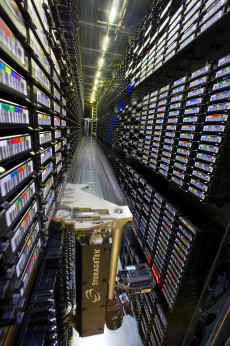NERSC Cited for Innovative Use of Globus Online
Users Benefit from Drag-and-drop Archiving
April 14, 2011
Jon Bashor, jbashor@lbl.gov, +1 510 486 5849
At GlobusWORLD 2011, held April 11-13 at Argonne National Laboratory, NERSC was awarded "Most Innovative Use of Globus Online" for using it to archive data onto HPSS. What makes the NERSC application unique is that Globus Online was originally developed as a reliable and secure tool for moving data between remote sites, but NERSC staff also found that it could be used to easily move data between computing systems and the center's HPSS data archive.
Archiving data has traditionally involved running command-line tools, but several NERSC users have requested a graphical user interface (GUI) to move data between HPSS and compute systems. A GUI makes it easier to back up or restore relevant data. Using Globus Online, NERSC demonstrated a "Drag and Drop Archiving" capability which is currently being tested and will be available to the NERSC user community shortly.
"Users have been asking for an easy way to access and archive their data and Globus Online's drag-and-drop interface gives them this option," said Shreyas Cholia, who presented the case study in his talk on "Globus Online @ NERSC" as part of a conference session on "Globus Community Updates and User Experiences."
Also contributing to the implementation and testing are Nick Balthaser, and Matt Andrews of NERSC, and Michael Link and Karl Pickett of Argonne National Lab. The system is still being fine-tuned and is expected to go into full production soon.
Moving to Globus Online was relatively straightforward as the NERSC systems already had an existing grid infrastructure with Globus authentication and GridFTP pre-configured. This allowed Globus Online to plug right into the NERSC systems.
The Globus Online hosted service manages the entire operation, monitoring performance and errors, retrying failed transfers, correcting problems automatically whenever possible, and reporting status to users. The Globus Online service can be found at http://www.globusonline.org.
⨠Read a case study about NERSC's use of Globus Online.
About NERSC and Berkeley Lab
The National Energy Research Scientific Computing Center (NERSC) is a U.S. Department of Energy Office of Science User Facility that serves as the primary high performance computing center for scientific research sponsored by the Office of Science. Located at Lawrence Berkeley National Laboratory, NERSC serves almost 10,000 scientists at national laboratories and universities researching a wide range of problems in climate, fusion energy, materials science, physics, chemistry, computational biology, and other disciplines. Berkeley Lab is a DOE national laboratory located in Berkeley, California. It conducts unclassified scientific research and is managed by the University of California for the U.S. Department of Energy. »Learn more about computing sciences at Berkeley Lab.








